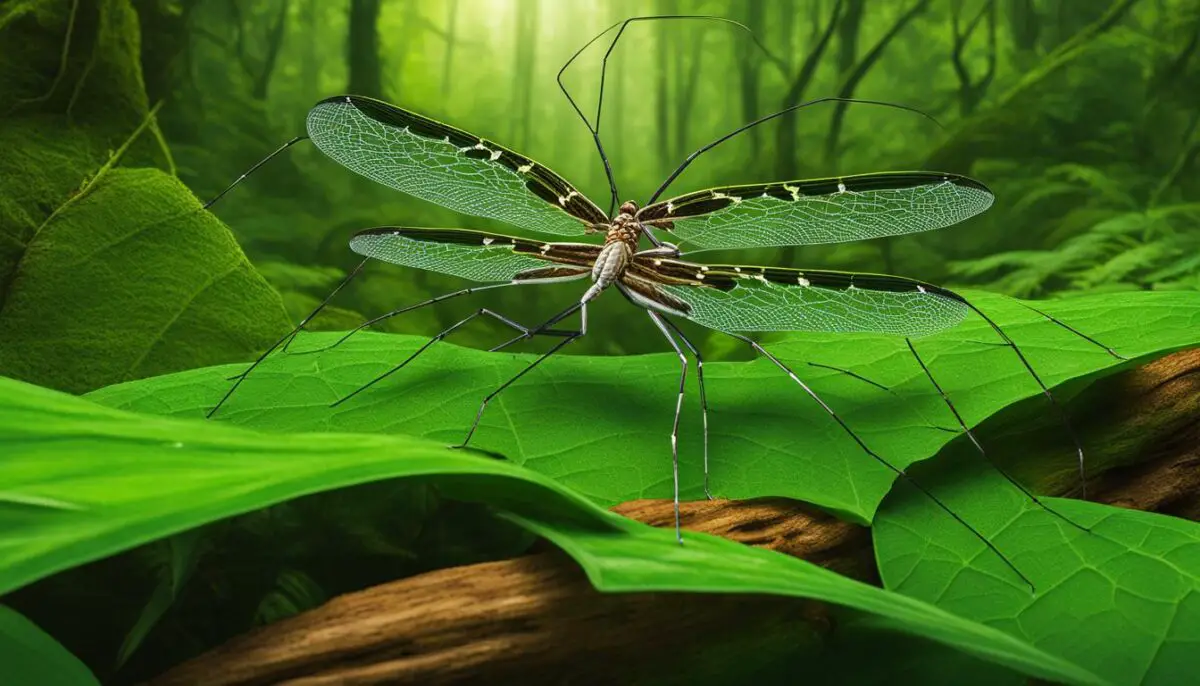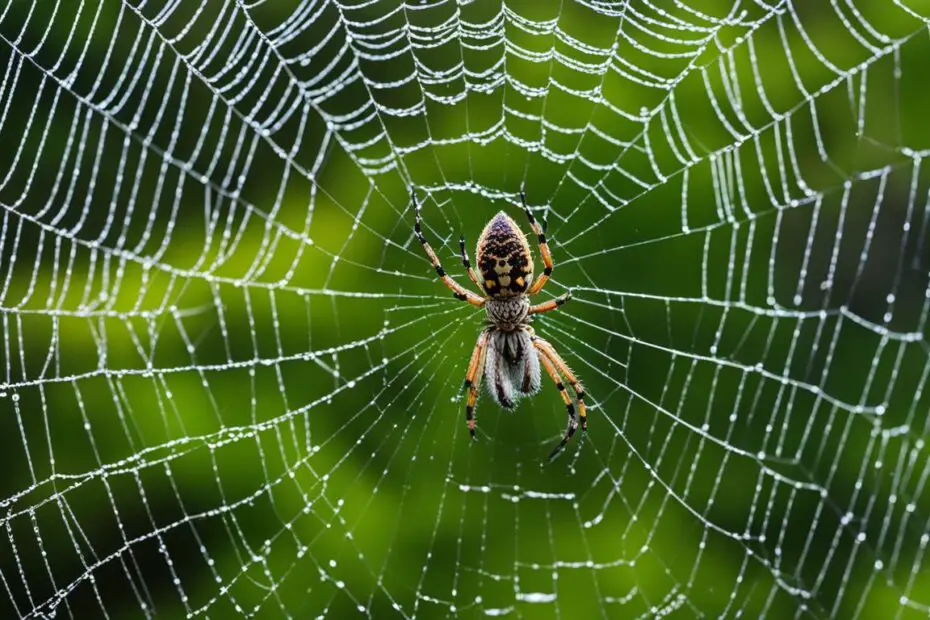Oregon is home to a diverse array of garden spiders. While some people may fear these creepy-crawly creatures, most garden spiders in Oregon pose no threat to humans. However, being able to identify the different species can be beneficial, especially in the rare event of a spider bite. From the newly discovered Cryptomaster behemoth to the commonly seen Zebra jumper and Cross orb weaver, there are plenty of fascinating garden spiders to explore in Oregon.
Key Takeaways
- Oregon is home to a diverse array of garden spiders.
- Most garden spiders in Oregon pose no threat to humans.
- Identifying different spider species can be beneficial in the rare event of a spider bite.
- Explore fascinating garden spiders in Oregon, including the newly discovered Cryptomaster behemoth, Zebra jumper, and Cross orb weaver.
- Understanding garden spiders in Oregon can lead to a greater appreciation for these creatures and their contributions to the environment.
The Cryptomaster Behemoth: A Newly Discovered Daddy Longlegs in Oregon
The Cryptomaster behemoth is a recently discovered species that belongs to the daddy longlegs family. While not technically a spider, it is still an interesting arachnid found in mountainous and forested regions of southwest Oregon. Scientists believe that there are potentially many more undiscovered arachnids in Oregon. This highlights the incredible biodiversity of spiders in the state.
“The discovery of the Cryptomaster behemoth signifies a milestone in the study of arachnids. This newly discovered species captivates researchers with its unique characteristics and its contribution to the already diverse ecosystem of Oregon’s mountainous regions.” – Dr. Emma Davis, Arachnologist
Given its classification as a daddy longlegs, the Cryptomaster behemoth shares similar traits with its spider relatives. It has a compact body and long, slender legs that resemble those of daddy longlegs spiders. However, unlike true spiders, it lacks venom glands and does not produce silk for web-spinning.
The Cryptomaster behemoth is an elusive arachnid that resides in the mountainous regions of southwest Oregon. Its preferred habitat includes dense forests and remote areas, making sightings a rare occurrence. The discovery of this species sheds light on the diverse arachnid population within the state, prompting further exploration and research.

| Characteristics | Details |
|---|---|
| Scientific Name | Cryptomaster behemoth |
| Common Name | Daddy Longlegs (not a spider) |
| Habitat | Mountainous regions of southwest Oregon |
| Physical Features | Compact body, long slender legs |
While the Cryptomaster behemoth adds to the rich tapestry of Oregon’s arachnid diversity, it also highlights the need for further exploration and study. Scientists speculate the existence of numerous undiscovered species, waiting to be unveiled in the untamed wilderness of Oregon’s mountainous landscapes.
Common Outdoor Spiders in Oregon Gardens
When it comes to garden spiders in Oregon, two common outdoor species that you’re likely to encounter are the Zebra jumper and the Cross orb weaver. These fascinating creatures play an important role in maintaining the delicate balance of garden ecosystems.
The Zebra jumper is often spotted on the exterior walls of houses, showcasing its excellent vision as it goes about its hunting activities. Unlike other spiders, the Zebra jumper doesn’t rely on webs to catch its prey. Instead, it stalks and pounces on them, exhibiting hunting behavior similar to cats. This agile and visually aware spider contributes to controlling the population of flies and other flying insects in your garden.

On the other hand, the Cross orb weaver is known for its remarkable ability to create large intricate webs. These webs, typically built in late summer and early fall, serve as perfect traps for unsuspecting flying insects. Cross orb weavers are skilled architects, constructing strong and efficient webs that allow them to secure a steady supply of prey. Their presence in your garden can significantly reduce the abundance of flies, making them valuable allies in pest control.
Habitat Preferences, Behavior, and Characteristics
Understanding the habitat preferences, behavior, and characteristics of these garden spiders can provide valuable insights into their role in your garden. Here are some key details:
The Zebra jumper:
- Habitat: Exterior walls of houses, trees, shrubs, and grassy areas
- Behavior: Stalking and pouncing on prey, excellent vision
- Characteristics: Agile and visually aware
The Cross orb weaver:
- Habitat: Gardens, forests, and wooded areas
- Behavior: Building large webs, capturing flying insects
- Characteristics: Skilled architects, excellent web-building abilities
By gaining a deeper understanding of these garden spiders’ habitat preferences, behavior, and characteristics, you can appreciate their important role in maintaining a balanced ecosystem in your Oregon garden. From their hunting prowess to their architectural skills, these spiders contribute to the natural control of insect populations, making your garden a healthier and more thriving environment.
Spiders Commonly Found in Oregon Homes
When it comes to house-dwelling spiders in Oregon, there are a few species that are commonly encountered. While the presence of spiders may cause some unease, it’s essential to understand that most of these spiders pose no threat to humans. Let’s take a closer look at two common species that make their way into Oregon homes.
Yellow Sac Spider
The yellow sac spider, originally from Europe, is one species that is often found indoors in Oregon. These spiders are nocturnal and actively hunt for insects during the night. Unlike other spiders, they do not build traditional webs but instead construct silk sacs in corners, on walls, and even on ceilings as their sleeping quarters.
Yellow sac spiders are generally harmless to humans, and their bites are rarely a cause for concern. While their bites may cause slight discomfort and localized irritation, severe symptoms are uncommon. It is important to note that reactions to spider bites can vary from person to person, so it’s always a good idea to seek medical attention if you experience any unusual symptoms or discomfort after a spider bite.
Mouse Spider
The mouse spider, another commonly encountered species in Oregon homes, is also an immigrant from Europe. These spiders are active during the summer nights and share similarities with the yellow sac spider in their hunting behavior.
The mouse spider’s name might sound alarming, but it is worth noting that it does not prey on mice. Instead, it hunts a variety of small insects, which makes them beneficial in controlling pest populations in and around the house.
Similar to the yellow sac spider, the mouse spider’s bites are generally harmless to humans. While their venom is potent enough to subdue their prey, it’s not considered dangerous to humans. However, as always, if you experience any concerning symptoms after a spider bite, it is recommended to seek medical advice.
Contrary to popular belief, it’s important to note that there are no brown recluse spiders in Oregon. The yellow sac spider and the mouse spider are often mistaken for brown recluses due to their similar appearance, but they lack the same venomous bite.
When encountering spiders in your home, it’s best to maintain a calm and cautious approach. If you feel the need to handle or remove them, it’s advised to wear gloves and use a gentle approach to avoid potential bites.
“The yellow sac spider and the mouse spider are common house-dwelling spiders in Oregon. Although their presence may cause concern, their bites are generally harmless.”
Conclusion
Oregon is home to a vast array of garden spiders, with over 500 species found in the state. From graceful orb weavers and agile jumping spiders to crafty crab spiders and elusive grass spiders, there is a remarkable diversity of spider species to discover. While some spiders may occasionally venture into homes, it is important to note that most pose no threat to humans.
Understanding the unique characteristics, behaviors, and habitats of these spiders is key to appreciating their role in the delicate ecosystems of Oregon gardens. By learning about the different types of garden spider species in Oregon, individuals can foster a greater admiration for these fascinating creatures and their contributions to the environment.
Whether you are interested in Oregon spider facts, spider identification, or want to create your own Oregon garden spider guide, exploring the world of garden spiders in Oregon can be both educational and captivating. These amazing arachnids deserve our respect and protection as important members of our natural ecosystems.
FAQ
Are garden spiders in Oregon dangerous to humans?
Most garden spiders in Oregon pose no threat to humans. However, it is important to be able to identify the different species in the rare event of a spider bite.
What is the Cryptomaster behemoth?
The Cryptomaster behemoth is a recently discovered species that belongs to the daddy longlegs family. While not technically a spider, it is an interesting arachnid found in mountainous and forested regions of southwest Oregon.
What are the common outdoor spiders found in Oregon gardens?
Two common outdoor spiders found in Oregon gardens are the Zebra jumper and the Cross orb weaver. The Zebra jumper is frequently seen on exterior walls and hunts its prey similar to cats. The Cross orb weaver builds large webs in late summer and early fall.
Do spiders commonly make their way into Oregon homes?
Yes, several spider species commonly make their way into Oregon homes. The yellow sac spider and the mouse spider are two examples. While their bites are generally harmless, it’s important to be aware of their presence.
How many garden spiders species are found in Oregon?
Oregon is home to over 500 species of garden spiders, ranging from orb weavers to jumping spiders, crab spiders, and grass spiders.

